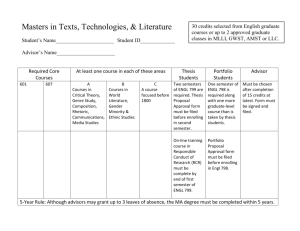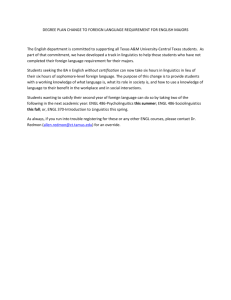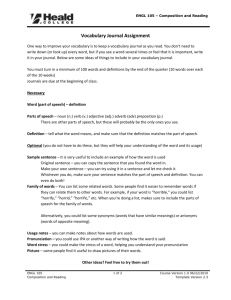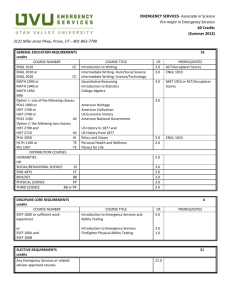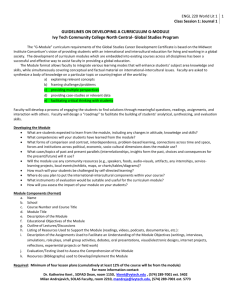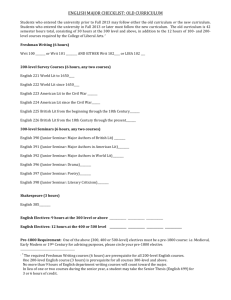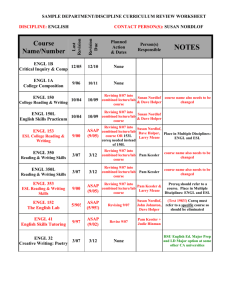Class Session 16 - Ivy Tech Community College
advertisement
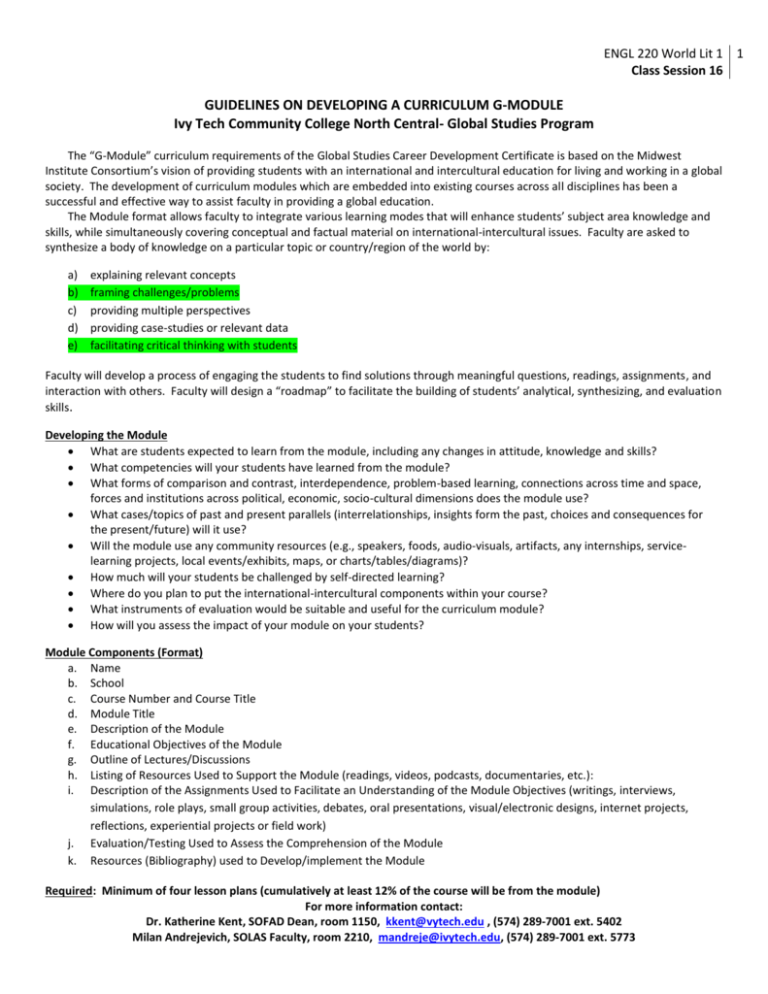
ENGL 220 World Lit 1 1 Class Session 16 GUIDELINES ON DEVELOPING A CURRICULUM G-MODULE Ivy Tech Community College North Central- Global Studies Program The “G-Module” curriculum requirements of the Global Studies Career Development Certificate is based on the Midwest Institute Consortium’s vision of providing students with an international and intercultural education for living and working in a global society. The development of curriculum modules which are embedded into existing courses across all disciplines has been a successful and effective way to assist faculty in providing a global education. The Module format allows faculty to integrate various learning modes that will enhance students’ subject area knowledge and skills, while simultaneously covering conceptual and factual material on international-intercultural issues. Faculty are asked to synthesize a body of knowledge on a particular topic or country/region of the world by: a) b) c) d) e) explaining relevant concepts framing challenges/problems providing multiple perspectives providing case-studies or relevant data facilitating critical thinking with students Faculty will develop a process of engaging the students to find solutions through meaningful questions, readings, assignments, and interaction with others. Faculty will design a “roadmap” to facilitate the building of students’ analytical, synthesizing, and evaluation skills. Developing the Module What are students expected to learn from the module, including any changes in attitude, knowledge and skills? What competencies will your students have learned from the module? What forms of comparison and contrast, interdependence, problem-based learning, connections across time and space, forces and institutions across political, economic, socio-cultural dimensions does the module use? What cases/topics of past and present parallels (interrelationships, insights form the past, choices and consequences for the present/future) will it use? Will the module use any community resources (e.g., speakers, foods, audio-visuals, artifacts, any internships, servicelearning projects, local events/exhibits, maps, or charts/tables/diagrams)? How much will your students be challenged by self-directed learning? Where do you plan to put the international-intercultural components within your course? What instruments of evaluation would be suitable and useful for the curriculum module? How will you assess the impact of your module on your students? Module Components (Format) a. Name b. School c. Course Number and Course Title d. Module Title e. Description of the Module f. Educational Objectives of the Module g. Outline of Lectures/Discussions h. Listing of Resources Used to Support the Module (readings, videos, podcasts, documentaries, etc.): i. Description of the Assignments Used to Facilitate an Understanding of the Module Objectives (writings, interviews, simulations, role plays, small group activities, debates, oral presentations, visual/electronic designs, internet projects, reflections, experiential projects or field work) j. Evaluation/Testing Used to Assess the Comprehension of the Module k. Resources (Bibliography) used to Develop/implement the Module Required: Minimum of four lesson plans (cumulatively at least 12% of the course will be from the module) For more information contact: Dr. Katherine Kent, SOFAD Dean, room 1150, kkent@vytech.edu , (574) 289-7001 ext. 5402 Milan Andrejevich, SOLAS Faculty, room 2210, mandreje@ivytech.edu, (574) 289-7001 ext. 5773 ENGL 220 World Lit 1 2 Class Session 16 GLOBAL STUDIES MODULE FORMAT Ivy Tech Community College North Central- Global Studies Program Name: Maribeth Anderson School: Ivy Tech Community College of Indiana—Region 10 Course Number and Title: ENGL 220 World Literature I CATALOG DESCRIPTION: World Literature I introduces students to influential world literature from ancient times through the mid-17th century. Included will be a discussion of the major historical, cultural, intellectual, and political events that shaped this literature. Students will analyze and evaluate classical world literature with respect to themselves and also analyze and evaluate world literature in relation to global contexts. Module Title: Reflection Description of the Module: [evaluation; meta-cognitive knowledge] Course Learning Objectives: 1. Examine oneself and one’s culture through multiple frames of literary reference, including the perception of others from around the world. 2. Use effective writing skills including ethical handling of primary and secondary sources. Educational Objectives of the Module (should constitute a minimum of 12% of the course): By the end of this session, you will be able to: reflect on your overall learning experience in World Literature I; communicate about those experiences using multimedia. Outline of Lectures/Discussions: Listing of Resources Used to Support the Module (readings, videos, podcasts, documentaries, etc.): Read: PowerPoint materials posted under the Resources button. Evaluation/Testing Used to Assess the Comprehension of the Module: Complete Final.3 Reflection** #3 Resources (Bibliography) used to Develop/implement the Module: Norton Anthology of World Literature, 3rd ed., Vol A Global Learning Integration Worksheet AACU Global Learning Value Rubric http://acu.org/resources/globallearning/index.cfm ENGL 220 World Lit 1 3 Class Session 16 ** Final Exam.3 Reflection (45 points): Due xxxx, by 5am Here’s your opportunity to get truly creative! Please submit via the appropriate link in the Class Session 16 folder. Create a PowerPoint® presentation in which you address the following: Your most positive discovery this semester, in terms of 220 course materials. Your most negative discovery this semester, in terms of 220 course materials. Your most surprising global connection/discovery, in terms of 220 course materials. The most useful tool you found (or someone found for you) this semester, overall. You should have at least four (4) slides serving as reflective responses to your semester’s work. It’s fine if you want to include more slides, just no less. (10 points per slide) If you’ve never created a PowerPoint slides, check out the PowerPoint® tutorial from Purdue’s Online Writing Lab (OWL) posted under the Resources button. I’ve also posted two other articles, under the Resources button, about how to improve PowerPoint® presentations. [Note: Please do not use the Office.org version of PowerPoint®; I have nothing but trouble opening/viewing these documents, even when converted! If you do not have access to this software, use Prezi (public), instead.] Relating to ‘Focus’ on the grade sheet, use titles/headings at the top of the slide to guide your viewer(s). If you find that you have too much text per slide, use the Notes field (see right below the slide) for full text (what you would actually write/say in a presentation) and the slide for visuals and textual prompts (bullet points, which must be grammatically parallel). Remember that PowerPoint® slides are, normally, orally presented. I always use the Notes to ‘talk my way’ through the actual presentation. The ‘power’ in a PowerPoint® is the combination of text and visual materials. Each slide will be evaluated on composition, the integration of textual and graphic materials (your own and/or others), content, and appropriate documentation (see grading sheet). For this (or any similar) assignment, a background is not considered a graphic! (The only exception to this requirement is a background that is content-driven; for example, you are writing about Odysseus meeting with the Cyclops and your background is a painting of that meeting.) Please use regular MLA formatting for the in-text citations on the slides; you can put your full bibliographic citations in the Notes field or on a separate Works Cited slide. Although this assignment is not designed for integrating outside textbased resources, you must document their use should you include any. You must cite any visual materials, unless you have created them yourself or you are using clip art! For 5 points, respond to the following: One question you should have asked in ENGL 220 but didn’t. You do not need to create a slide for this prompt; you can include in the Comments section when you submit or put in the Notes field of the concluding slide. Look over the following grading sheet to check on evaluation criteria! Remember that your PowerPoint® slides should combine text and graphics! ENGL 220 World Lit 1 4 Class Session 16 ENGL 220 Final.3: Reflection Grade Sheet (45 points) 1. Slide One (10) Positive _____ Focus (2) _____ Composition (6) _____ Integration of Text and Graphics _____ Content _____ Documentation/Grammar & Mechanics (2) Subtotal: _____ 2. Slide Two (10) Negative _____ Focus (2) _____ Composition (6) _____ Integration of Text and Graphics _____ Content _____ Documentation/Grammar & Mechanics (2) Subtotal: _____ 3. Slide Three (10) Most Surprising Global Connection/Discovery _____ Focus (2) _____ Composition (6) _____ Integration of Text and Graphics _____ Content _____ Documentation/Grammar & Mechanics (2) Subtotal: _____ 4. Slide Four (10) Useful Tool _____ Focus (2) _____ Composition (6) _____ Integration of Text and Graphics _____ Content _____ Documentation/Grammar & Mechanics (2) Subtotal: _____ ENGL 220 World Lit 1 5 Class Session 16 5. One question you should have asked in ENGL 220 but didn’t. (5) Subtotal: _____ Additional Comments: Total: ________
